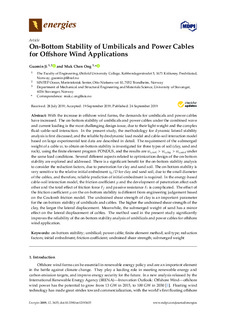| dc.description.abstract | With the increase in offshore wind farms, the demands for umbilicals and power cables have increased. The on-bottom stability of umbilicals and power cables under the combined wave and current loading is the most challenging design issue, due to their light weight and the complex fluid–cable–soil interaction. In the present study, the methodology for dynamic lateral stability analysis is first discussed; and the reliable hydrodynamic load model and cable–soil interaction model based on large experimental test data are described in detail. The requirement of the submerged weight of a cable w s ws to obtain on-bottom stability is investigated for three types of soil (clay, sand and rock), using the finite element program PONDUS, and the results are w s,rock >w s,clay >w s,sand ws,rock>ws,clay>ws,sand under the same load conditions. Several different aspects related to optimization design of the on-bottom stability are explored and addressed. There is a significant benefit for the on-bottom stability analysis to consider the reduction factors, due to penetration for clay and sand soil. The on-bottom stability is very sensitive to the relative initial embedment z 0 /D z0/D for clay and sand soil, due to the small diameter of the cables, and therefore, reliable prediction of initial embedment is required. In the energy-based cable–soil interaction model, the friction coefficient μ μ and the development of penetration affect each other and the total effect of friction force F f Ff and passive resistance F r Fr is complicated. The effect of the friction coefficient μ μ on the on-bottom stability is different from engineering judgement based on the Coulomb friction model. The undrained shear strength of clay is an important parameter for the on-bottom stability of umbilicals and cables. The higher the undrained shear strength of the clay, the larger the lateral displacement. Meanwhile, the submerged weight of sand has a minor effect on the lateral displacement of cables. The method used in the present study significantly improves the reliability of the on-bottom stability analysis of umbilicals and power cables for offshore wind application | |

